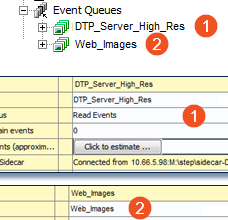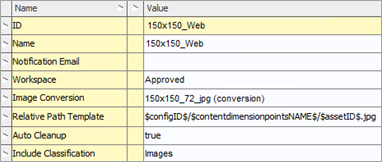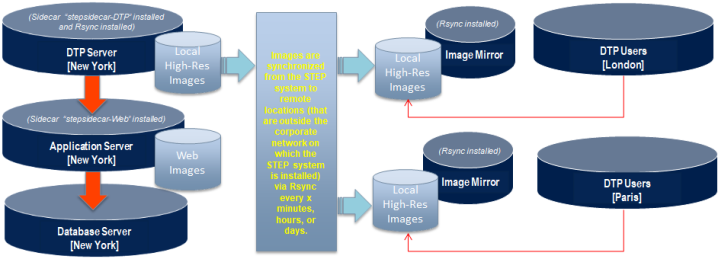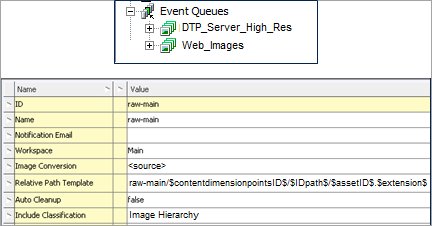Note: Note: The use case described in this topic is only applicable for on-premises installations of STEP. Because it is not possible to install Asset Push Sidecars on Stibo Systems SaaS environments, rsync can only be used on customer-hosted servers. One example of an rsync use case applied to a customer-hosted sever is a dedicated Asset Push File Server used for provisioning assets further to other locations. Additionally, it is not possible to use rsync on an InDesign server provisioned in Stibo Systems SaaS.
The following topic covers a use case for using rsync to synchronize an image folder from the 'base' system to two 'remote' systems.
Use Case Assumed Requirements
In this use case example, a customer uses the Main workspace for Print and the Approved workspace for the web images. The high-resolution images must be located on a drive on the DTP server, but the web images must be placed on a drive that is installed on the Application Server. In addition to these requirements, users at two remote sites in London and Paris will be working with InDesign clients and need a local 'mirror' of the high-resolution images folder on a machine that is local to them.
Important: These two remote machines are not on the same corporate network as the STEP system, so the Asset Push Sidecars cannot be installed on these machines at the remote locations.
There are three web conversions that are controlled by three configurations that should take place. The web image resolutions are 80x80, 150x150, and 300x300 all at 72DPI. The web images for each configuration may all go into one 'flat' folder per configuration since there is no need for a folder structure to house these low-resolution images. There is no conversion required for the high-resolution images – the source file in STEP should be pushed out in its original format and resolution.
Solution Overview
In this use case, two Sidecars will be set up.

One Sidecar will handle the push of high-resolution images to a local machine. This sidecar will usually be the system where the InDesign server is installed. The other Sidecar for the web images will have three configurations with each one performing the appropriate conversion for the resolution and size. The following is an example of one of the web image conversions.

In this use case, a third-party software program will be used to synchronize the high-resolution images on the DTP server to machines residing on a different corporate network in London and Paris. This example uses rsync, but there are other software packages available for PC, Mac, and Linux.

- The machine in London is designated to run rsync and hold a local version of the STEP high-resolution images on a local network-shared hard drive. Users in London will access these local images within this network. The drive letter or name that is used for that networked drive must be the same as what defined in the assetpush.properties file.
- The system in Paris will be set up in the same way as the system in London.
- The DTP Server will have a STEP Sidecar installed and will house the images that will be used by the InDesign Server for Proof Views, PDF Generation, DTP page generation, and support other Print Flatplanner and Print AutoPage functions. It will also support any InDesign users that are local to the STEP Application and Database servers.
- The Application Server will have its own STEP Sidecar installed and will house the three folders that hold the low-resolution web images. Those images are usually be placed in a shareable hard drive on the Application server.
There is only one Sidecar set up to handle the high-resolution images. Via the use of rsync, the folder structure and the images in London and Paris will be a 'mirror image' of the images pushed out via this configuration. This is so that documents that are produced at one location and that have images mounted will all have an image path that is 100% compatible with the image folder structure in the other two locations. Without this consistency, documents that are produced in one location and opened in another location will all have missing linked images.

The old image conversion called DCS (AssetPush_highres) can be replaced with the new internal conversion of <source>. With this selection, no conversion is performed.